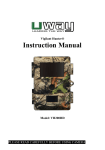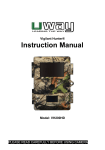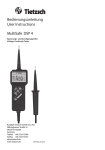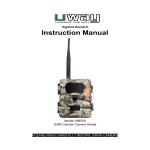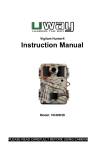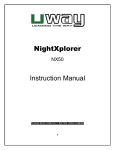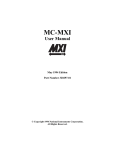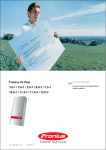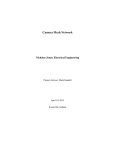Download UWAY MB600 3G User Manual (English)
Transcript
Vigilant Hunter® Instruction Manual Model: MB600 HSPA+ / GSM Cellular Camera Model PLEASE READ CAREFULLY BEFORE USING CAMERA Thank you for Purchasing your UWAY Camera The UWAY Vigilant Hunter is a high quality digital surveillance camera. It has been precisely engineered and tuned to provide you with optimal and consistent performance. This camera will provide high quality digital pictures and sound recording video for applications such as home, cabin, and business surveillance and animal monitoring for hunting and research. It features a highly sensitive Passive Infra-Red (PIR) motion sensor and numerous setting options to tailor the camera to your particular needs. Item Check List Camera and Antenna Needed for Operation USB cable Nylon mounting strap Warranty Card Twelve (12) AA Lithium/Alkaline or NiMH Rechargeable Batteries SD or SDHC Card (up to 32G) Standard Cellular SIM Card *It is recommended to use Lithium or High Quality NiMH in camera to maximize camera performance and battery life. SPECIAL HANDLING PRECAUTIONS CAMERA: The camera has been finely tuned. Avoid dropping and physical shock. The camera is designed for typical weather conditions. It is not waterproof for use underwater. Carefully clean debris from camera lens, PIR, and LED platform. Avoid use of cleaning solvents. The camera contains precise electronic equipment. Do not attempt to open camera case yourself. Condensation may form on lens and electrical components when bringing into warm room from cold. To avoid this, first place camera inside a sealed plastic bag before bringing into warm room temperature. If condensation forms, remove SD card and batteries until camera is dry. Remove batteries when storing camera. Removing batteries from the camera during storage reduces the risk of battery acid leakage and battery drain. Do not mix old and new batteries together in the camera. LCD SCREEN: Avoid exposing screen to direct sunlight or at high temperatures as LCD damage may occur. Page | 1 Antennae Color Display Battery Compartment SD Card Slot SIM Slot Snap Lock Padlock Hole Padlock Hole Snap Lock Ports & Slots: DC 6V Port USB Port Control Buttons: Up, Down, Left, Right Menu, OK ON/OFF/SETUP CELLULAR INFORMATION: This camera contains a HSPA+ cellular module to transmit pictures directly from the camera to your cellular phone and/or email address. It supports MMS/SMTP/E-mail via HSPA or GSM network. It supports four network bands: 850MHz, 900MHz, 1800MHz, and 1900MHz. A SIM card from a compatible provider is required to transmit photos. Photos are transmitted via MMS or SMTP. Cellular charges will apply for sending photos and potentially receiving photos/emails. Video does not send via cellular network. Photos are compressed to a smaller resolution to transmit over the network, while the full mega-pixel photo is saved to the SD card for future viewing. Page | 2 MOUNTING CAMERA: This camera is designed to use the UWAY Bracket (sold separately) to obtain maximal mounting versatility. Camera can be securely locked with cable lock (through camera, bracket, or both) or security box (with or without bracket). Camera can be mounted with nylon strap (included) or security box (sold separately). It is recommended to mount the camera 3 feet high overlooking desired area and ~30 feet away from target area for maximum sensitivity in most situations. Adjustments may be required depending on animal size and environment. PIR motion detection distance changes based on ambient temperature and setup. Higher ambient temperatures will reduce PIR motion detection range thereby requiring camera to be closer to desired location. Mounting camera too high or angling camera may result in animal or humans going under or above the PIR motion detection range. Angle the camera perpendicular to the ground to maximize the IR lighting potential. Mount at 45º degree angle to trails to maximize detection angle. Using UWAY Bracket (sold separately) provides optimal versatility when mounting the camera. UWAY XtendIR (sold separately) will significantly increase night IR lighting distances out to 60-100 feet. GETTING STARTED SD MEMORY CARD The camera supports both SD and SDHC memory cards up to 32 GB. The camera does not have any internal memory and will not turn ON without SD card inserted. 1. 2. 3. 4. Open camera Insert SD card with marked side facing front of camera Push gently until card clicks into place Push card again to remove Note 1: Ensure SD card is NOT in locked position. Note 2: Format SD card in camera before using each time. This will create a file on the SD card where the camera will save images to. Note 3: It is always recommended to test the SD card by taking some pictures to ensure SD card works properly before leaving camera for extended periods of time. WARNING: Make sure camera is OFF when adding or removing SD memory card. Page | 3 BATTERIES This camera is designed for Lithium/Alkaline or Nickel Metal-Hydride (NiMH) batteries. An AC to DC power cord (sold separately) can be attached to the bottom port of the camera. Insert 12 AA batteries while ensuring polarity (+ -) is correctly orientated. Note: 6V or 9V DC power can be used with or without batteries inserted. External power bypasses the batteries when 6V or 9V power is connected. Solar panels DO NOT charge batteries directly located in the camera. WARNING: Do not use 12V external battery power as camera damage will occur. CHECKING BATTERY LEVEL Battery level can be seen in bottom left corner of viewer screen TESTING AND WORKING MODES The camera has two modes: Set Mode and Work Mode. 1. 2. Turn switch to middle position to access SET mode. The camera will enter Live Preview Mode automatically. If the camera beeps, it means either no SD card is inserted or the SD card is not inserted properly. The SD card needs to be inserted or reinserted to continue. Turn switch to far right to access WORKING mode. A blue LED light will blink for 510 seconds before the camera is capable of being triggered by motion. Note: The LCD screen has a built in sleep mode to save power. If LCD screen turns off, you must turn camera OFF and back to SET mode to reset. MENU OPERATIONS AND SETTINGS MAIN MENU The Menu has 3 options: I. Camera Settings, II. Additional Settings, or III. Cellular Setup. Camera Settings will allow you to setup parameters on how you want the camera to function. Additional Settings will assist you in setting date, time, power type, formatting SD card. Cellular Setup will assist you in setting up the camera on the network. Page | 4 LIVE PREVIEW This option allows the user to view in real time what the camera is capturing. Pictures/videos can be captured using the “OK” button while in this mode. This camera is equipped with a Day Color Mode and Night IR Mode while in Live Preview. It is recommended to minimize the use of Night IR Mode to avoid battery depletion. 1. Turn camera to SET mode and LIVE PREVIEW mode is displayed automatically. If you are already in main menu, push MENU button to enter LIVE PREVIEW mode. PHOTO MODE a. Push ‘Right arrow’ button (you will see photo icon) b. Push UP Arrow to switch between Day Color and Night IR Mode c. Push OK button to capture pictures VIDEO MODE a. Push LEFT Arrow button (you will see video icon) b. Push UP Arrow to switch between Day Color and Night IR Mode c. Push OK button to start and stop video capture 2. Push MENU button to return to menu PHOTO / VIDEO PLAYBACK This feature allows the user to view pictures and video stored on the SD card. User can pause, stop, rewind, and fast forward video during playback. 1. During LIVE PREVIEW mode push the DOWN arrow to access PLAYBACK or select PLAYBACK from CAMERA MODE in Camera Settings Menu 2. Use LEFT and RIGHT arrow to select video or picture and push OK to select 3. Pictures display Camera in bottom left corner while Videos display a film strip icon in bottom left corner. 4. Follow prompts on bottom of LCD screen while in PLAYBACK mode VIDEOS a. Push OK to PLAY and UP arrow to PAUSE PICTURES a. Push OK to SEND photo over network 5. DOWN arrow returns you to LIVE PREVIEW mode 6. Push MENU button to return to menu when in LIVE PREVIEW mode Page | 5 I. CAMERA SETTINGS MENU CAMERA MODE This camera can be set to capture still pictures OR video. 1. Select CAMERA MODE 2. Select Capture Image for PHOTO mode, Video Record for VIDEO mode, or Playback using UP or DOWN arrow and push OK to set PHOTO RESOLUTION Photo resolution can be set at (4:3): 8MP, 5MP or 3MP or (16:9): 6MP, 4MP, or 2MP 1. Select PHOTO RESOLUTION 2. Select desired photo resolution and push OK to set PHOTO BURST This feature allows the camera to take from 1-5 photos in rapid succession following each trigger. 1. Select PHOTO BURST 2. Push OK 3. Select desired number of photos per trigger and push OK to set VIDEO RESOLUTION Video mode includes High Definition HD 1280 x 720 or VGA 640 x 480. 1. Select VIDEO RESOLUTION 2. Select HD or VGA mode and push OK to set VIDEO LENGTH Video length can be set in 1 sec increments from (5s – 30s). Longer video lengths will deplete battery power and memory more quickly than lower lengths. 1. Select VIDEO LENGTH 2. Select desired video length and push OK to set VIDEO SOUND Video sound recording can be turned ON or OFF. 1. Select VIDEO SOUND 2. Select ON or OFF and push OK to set QUIET TIME Also known as, “Time Interval or Delay Time”, this feature puts the camera to sleep after capturing an image for the selected period of time before it can be re-activated by motion. Times vary from 5 seconds to 60 minutes. Page | 6 1. Select QUIET TIME 2. Select desired ‘quiet time’ and push OK to set NOTE: The camera is only able to do one thing at a time; it has one internal processor. When in cellular mode, the camera must finish transmitting the image before it can capture a subsequent image. Average transmission speed will range 10 seconds to 3 minutes depending on the network strength at that time and location. ILLUMINATION This feature allows the user to use external lighting (XtendIR-B) or turn off IR lights if no lights are required in the night. User selects Internal when they want the IR lights of camera to work normally; select External if connecting XtendIR-B (sold separately) to the camera OR to turn IR lights OFF at night, and Int + Ext if both the XtendIR-B and camera IR lights are desired. 1. Select ILLUMINATION 2. Select Internal, External, or Internal + External and push OK to set PIR SENSITIVITY This allows the user to adjust motion sensitivity slightly. (Eg. High makes the camera most sensitive.) 1. Select PIR Sensitivity 2. Select Low, Normal, High DUTY TIME This feature allows the user to program the camera to turn ON and OFF at a specified time. 1. Select DUTY TIME 2. Select ENABLE to set up Duty Time or DISABLE to cancel Duty Time SET START TIME Set camera START time using arrows and push OK to set SET STOP TIME Set camera STOP time using arrows and push OK to set 3. Push LEFT arrow button to return to menu Note: For 24 hour activity: START: 00:00 and STOP 23:59 TIME LAPSE This feature allows the camera to take pictures at a pre-set time interval (10 seconds to 12 hours) and record or send them over the network. Page | 7 NOTE: When in cellular mode, it is important to understand the cellular limitations. For example, it may not be a good idea to set time-lapse interval to short as you will maximize the daily limit quickly. Furthermore, setting a time-lapse interval will require taking into consideration the cellular transmission speed. 1. Select TIME LAPSE 2. Select ENABLE to set up time lapse or DISABLE to cancel time lapse 3. Set START TIME and push OK to set 4. Set END TIME and push OK to set 5. Set DELAY TIME and push OK to set 6. Push LEFT arrow button to return to menu II. ADDITIONAL SETTINGS LANGUAGE Select your desired language DATE / TIME STAMP This allows the user to have the date, time, and temperature stamped onto each photo or video. 1. Select TIME STAMP 2. Select NO or YES and push OK to set SET DATE / TIME This feature allows the user to set the display format for date and time, as well as set the current date and time. 1. Select SET DATE / TIME 2. Select one of the three menu options: 3. Push LEFT arrow button to return to menu when finished DATE FORMAT Select the desired Date Format and push OK to set TIME FORMAT Select desired Time Format and push OK to set SET DATE / TIME Set date and time using UP, DOWN, RIGHT and LEFT arrow and push OK to set TEMPERATURE Allows the user to select either Fahrenheit or Celsius temperature settings. Page | 8 1. Select TEMPERATURE 2. Select Fahrenheit or Celsius and push OK to set POWER TYPE This camera is a precisely tuned instrument. It is recommended to use high quality Alkaline, Lithium or high quality NiMH batteries. Programming which batteries are present increases accuracy of battery level meter. This camera can also be connected to a 6V or 9V external battery pack (sold separately). 1. Select POWER TYPE 2. Select Lithium/Alkaline, NiMH batteries, DC 6V or DC 9V and push OK to set FORMATTING SD CARD Formatting the SD card removes all files on the memory card and prepares it for use in the camera. It is recommended that the SD card is formatted in the camera prior to each use. 1. Select FORMAT 2. Select YES to format SD card 3. Push OK to proceed with formatting SD card ACCESS CONTROL This feature allows the user to set a 4-digit password to deter theft and render the camera unusable without the password. Select ACCESS CONTROL SET PASSWORD Select desired password using ARROWS and push OK to set DISABLE PASSWORD Select and push OK to disable password DEFAULT SET This feature resets the camera to factory default settings. CAMERA INFORMATION Select CAMERA INFORMATION from main menu FILES COUNT Displays PICTURE and VIDEO number STORAGE Page | 9 Displays SD memory card USED SPACE and FREE SPACE FIRMWARE VERSION Displays the current camera firmware version UPGRADE User can upgrade camera firmware. Place firmware files on ‘EMPTY’ SD card. Insert card into camera and Select UPDATE III. CELLULAR SETUP This menu is for setting up the cellular network. Cellular setup can be accomplished either by using the Download Tool with a computer (for comprehensive settings) or by direct setup on camera (for quick and basic settings). **SKIP TO ‘USING CAMERA ONLY’ SECTION TO SETUP CELLULAR NETWORK IF YOU WANT TO AVOID USING A COMPUTER TO SETUP Using Download Tool to set up Cellular Network Settings 1. Insert a SD card and a SIM card into camera 2. Access CELLULAR SETUP from Main Menu and select DOWNLOAD TOOL 3. Press OK to download the "UWAYTOOL.zip" onto the SD card 4. Use a computer to unzip the ZIP file, and then open "UWAYTOOL.exe" file Page | 10 See the graphics below for reference A. Send Mode: OFF: turns off the cellular function; camera functions without cellular functionality. Page | 11 INSTANT: to send a picture instantly when the camera captures a picture. When this option is selected, you need to set a Max Num. Max Number defines the maximum pictures that will be sent within 24 hours. For instance, 20 means the camera will only send the first 20 pictures within 24 hours regardless of the actual number of pictures captured that day. Note: The Max Num. cannot exceed 200 in Instant mode. CUSTOM: to send the pictures at a user-defined time in one day. When this option is selected, you need to set Max Num. (same as above in 'Instant') and Send Time. For example, Max Num. 10 and Send Time 18:30, the camera will send the first 10 pictures taken in that day at 18:30. Note: The Max Num. cannot exceed 50 in Custom mode. DAILY REPORT: to send a SMS (text message) report at a user-defined time. The report includes total picture/video number captured during the past 24 hours, the battery level and remaining storage space. Page | 12 B. Send Via: The camera provides two solutions, i.e. MMS or SMTP, to send the pictures to the desired phone numbers and email addresses. MMS: uses MMS cellular plan If MMS is selected, pictures will be sent to the preset phone numbers (maximum 4 numbers allowed) and email addresses (maximum 4 addresses allowed) or both phone number and email address (use semicolon ";" between each phone number and email address). SMTP: uses Data cellular plan If SMTP is selected, pictures will be sent from one preset sending email address to one or multiple email addresses via HSPA network using the SIM card data plan. Page | 13 When SMTP is chosen, there is a reminder to ask the user to set the Sending Email. Click the "Sending Email" button; there would be another pop-up dialog box as shown below: Complete the above information and click "OK" to save. This email address will be the "Sender" email. Note: User can send email with SSL encryption (by choose "Use SSL"), C. Send To: This is to set the destination where the MMS/SMTP goes to. Phone: pictures to phone numbers (maximum 4 numbers) Email: pictures to email addresses (maximum 4 numbers) Both: pictures to both phone numbers and email addresses. NOTE: the ‘Both’ and ‘Phone’ options are only possible for MMS, not for SMTP. SMTP pictures can only be sent to email addresses (not phone numbers). Using more phone numbers and emails will result in more battery usage. D. Operator Parameter: The manufacturer has pre-set the parameters of some operators worldwide into the camera; user needs to select one of the operators as shown below: Page | 14 For instance, if the user uses an USA AT&T SIM card, choose "USA" in the "Country" drop down dialog, then choose "AT&T" in the "Operator" drop down dialog. If user cannot find the country or operator information in the preset software, the user needs to do custom settings and contact local operators to fill in the operator information. Choose "Other" in the "Country" drop down dialog; choose "Other" in the "Operator" drop down dialog, then click the "Custom" button to access a pop-up dialog box. Complete the following information (please confirm the accurate information with your local operator), and click OK to save the settings. Take Germany T-Mobile for example as shown below. Page | 15 E. Recipients: Recipients are where the pictures are transmitted to: phone number or email address. The recipients allow 4 phone numbers and 4 email addresses, use semicolon ";" between each phone number and email address. F. Remote Control: This feature allows the user to send a text message command to change certain settings. Page | 16 Disable: turns off remote control. 24 Hour: to allow camera to receive text message command in 24 hour mode. Note: this mode consumes more power since the Cellular module will be on standby all the time for incoming SMS messages, turn it off or switch to Once mode (see below) when this mode is no longer needed. Once: The cellular module will boot up automatically every day at the ‘Receive Time’ to check if there is any text message commands. After processing the text message command, the camera will send a confirmation text message to the sender phone number. If multiple commands are received, the camera will only process the last text message command if there is any command conflict. Note: Avoid sending multiple text message commands to camera in one day. The camera will accept text message commands in the following protocols to change the Send Mode shown in the table: Send Mode Off Instant Customized Daily Report Text Message Command Protocol #SMOFF# #SMINNN# #SMCHHMMNN# #SMDHHMM# Example #SMOFF# #SMI050# #SMC093030# #SMD1930# HH means hour, MM means minute, NN or NNN mean Max Number. Taking "#SMC093030" for example, this command will change the Send Mode to "Custom" with receiving time at 9:30 and Max Num. 30. Note 1: The command protocol must be followed accurately, all letters should be in capital case; otherwise, the camera will not accept the command. Page | 17 Note 2: Once the Send Mode is changed to OFF, the module will be turned off and will not receive any further text message commands; you will need to retrieve the camera to turn cellular mode back ON. Additional text message commands supported are: Disable 24 Hour Once Disable Change interval time Reset time lapse setting Snapshot Text Message Command Protocol Change Remote Control Mode #RTOFF# #RT24# #RT1HHMM# Change Time Lapse Setting #TLD# #TLNNNM# #TLSHHMMEHHMMINNN# Featured command #SNAP# Example #RTOFF# #RT24# #RT11130# #TLD# #TL060M# #TLS0530E2130I120# #SNAP# User can send text message commands to change the remote control modes as shown in the above table. HHMM means the wake up time for Once mode. For instance, #RT11130# means change the remote control mode to once a day and the Receive Time is 11:30am. Note: once the remote control is disabled, the camera will not accept any further text message commands. User can send text message commands to change the Time Lapse setting. NNN stands for interval time here, which is in unit of minute. Only 001 to 060, and then multiple of 60 (i.e. In hours) are legible. The max interval time is 720 minutes (i.e. 12 hours). For instance, #TLS0530E2130I120# means Starting Time 5:30, End Time 21:30, Interval Time 120 minutes. Command #SNAP# allows user to catch a snapshot from camera to send to the preset recipient phone number or email.. G. Photo Quality: User can choose the picture quality to be sent as either Normal or High.. Page | 18 Note: Normal quality is good for general purpose, high quality will increase the data size of sending picture which will result in longer sending time and more power consumption. H. Camera Name: User can input a camera name in the form of 4 digits; the camera name will be shown on the right corner of time stamp of each picture taken. Note: only 4 digits (0~9) are allowed, DO NOT use Space between digits. I. PATH Save the edited "UWAYTOOL.exe" after completing all information above to a location you can easily find on your compture. Click the "Save" button and a file named "SETUP.bin" will be generated in the designated location. Copy the "SETUP.bin" file onto the ROOT directory of a SD card (not in DCIM) and insert the SD card into the camera. NOTE: Switch the camera to "SETUP" and after a few seconds, the camera will display "Update Success". Testing the network using “manually send mode”: 1. Switch camera to "SETUP" 2. After the camera boots up into Live Preview, it will search for the network if a SIM card is inserted and the cellular module is NOT turned Off in "Send Mode". The user will see "Searching network....." on the screen. Once the camera is connected to the network, the ISP name will show on the bottom right corner of the screen. If the connection fails, it will show "Login fail". Press the "Right" key to search for network again. Note: continuously Login fail generally means the network signal is poor or the SIM card is not compatible. 3. While in Live Preview, press 'Down' arrow to switch to Playback mode, choose a picture using the "Right" or "Left" arrows and press OK. The camera will send the selected picture to the preset phone number(s) and email address(s). After sending successfully, the LCD screen will show ‘Send over’. If reception is poor or network is busy, it will show ‘Send Fail’. Page | 19 Sending a picture takes 5s-60s depending on the network signal strength. SMTP generally takes longer time than MMS. USING CAMERA ONLY TO SETUP CELLULAR SETTINGS 1. 2. 3. 4. Set SEND MODE: Off, Instant, Customized, or Daily Report Set SEND VIA: MMS or smtp Set SEND TO: Phone, Email, or Both Set NETWORK SETUP: NOTE: Push the OK button to select each letter/number. The disk icon is for saving settings; the large left arrow button is for deleting, and the small right arrow is to return to previous menu. a. Phone: enter phone number using arrows, press OK to save. b. Email: enter email address using arrows, press OK to save. c. Cellular Provider: select your provider from the menu. If your provider is not present, you will need to use the ‘Download Tool’ explained previously. 5. Set PHOTO QUALITY: Normal or High 6. 2G/3G MODE: 2G mode uses GSM cellular frequencies. 3G mode uses HPSA/+ cellular frequencies. NOTE: If the network does not support GSM, user should switch to 3G mode only. 7. Set REMOTE CONTROL: Disable, 24 Hour or Once. NOTE: Explanations of the above settings are explained in greater detail previously in manual (pg. 10 – 19). Additional Notes: Be sure your SIM card works on the GSM or HSPA service. This device supports four bands: 850MHz, 900MHz, 1800MHz and 1900MHz. If sending photos by MMS, you will want an MMS picture messaging plan. If sending photos by SMTP account, you will want a Data plan on the SIM card. There is a max limit on the number of pictures sent daily to your phone. Please check the MAX number in "Instant" and "Custom" modes to set the desired number of pictures. Page | 20 The signal strength of the mobile network may vary with location and time of day, which may lead to failures in sending pictures. Rain, rainstorms or bad weather may cause poor signal reception. Be sure to set up camera at a location with strong network coverage. ADDITIONAL INFORMATION TRANSFERRING PICTURES AND VIDEO TO A COMPUTER: Pictures and video can be removed in one of two ways: 1. SD memory card can be removed (ALWAYS ensure camera is OFF before removing) and transferred to computer or SD card reader. 2. Connect camera to computer using USB cable. i. Turn camera ON (may not be required) ii. Computer will recognize camera and prompt you to open file or save pictures TROUBLESHOOTING 1. I get more pictures saved to the SD card than transmitted to my phone number and/or email address i. After capturing a photo, the camera will attempt to transmit the photo a few times before aborting and prepare to capture another photo. ii. Poor reception or busy network signals may result in poor connectivity at certain times and places. iii. Increase Quiet Time to 1 – 3 min as the camera may not be able to transmit as fast in certain network areas. iv. Move camera to different location and test connection strength. v. Consider purchasing a stronger antenna. 2. I get pictures transmitted periodically / not consistent i. The cellular network reception strength will change throughout the day; when the network is busy, the range and strength of reception will decrease. 3. I cannot get the camera to transmit pictures properly i. Ensure your SIM card is compatible ii. Ensure the SIM card is active and not locked; you may need to confirm with your provider iii. Ensure you have the proper plan on your SIM card: MMS requires an MMS picture messaging plan, while SMTP requires data (may be slight variations with your provider). Page | 21 iv. 4. i. ii. 5. i. ii. iii. iv. 6. i. ii. iii. iv. 7. i. ii. iii. iv. 8. i. Make sure you follow carefully the Download Tool instructions or menu on the camera in setting up the network. The camera shows full or partial reception bars and I get login failure or no pictures transmitted Although the camera may show full or partial cellular power, the network may be busy at the time of transmission and login; keep trying or move to another location. In some instances the camera may show good reception but the cellular bandwidth is too small to transmit pictures at that time; trying at a later time or moving to a different location may help. The camera does not turn ON Ensure batteries are inserted properly with correct polarity and fully charged. If possible test each battery with battery tester. Approximately 1.7V for Lithium and 1.3V for NiMH is full power. Ensure SD card is properly inserted and not in locked position Reset camera by removing batteries and SD card for 10 minutes Cold temperature may decrease battery output sufficiently to prevent camera from turning ON; check batteries and ensure they are rated for cold temperature Beeping Noise when camera turns ON Insert SD card Ensure SD card is not locked Format SD card in camera SD card may not be compatible Camera will not take pictures or stops part way even with full batteries SD card is not formatted correctly; format SD card in camera Ensure SD card is not locked SD card is faulty or incompatible; try different SD card and/or brand. Faulty or incompatible SD cards may cause system conflict, system crash, and battery drain. Always format SD card in camera and try different SD cards if problem persists. Batteries do not have enough power to activate picture/video sequence Batteries run down quickly Avoid poor quality alkaline and rechargeable batteries, avoid mixing different brands and ages of batteries as battery life will be adversely affected. Different brands of batteries will perform differently than others; try other battery brands to find what works best for your environment. Page | 22 ii. iii. iv. v. Reduce number of picture burst and/or reduce video length. Ensure batteries are fully charged; test batteries with tester if possible In cold temperatures, the battery life becomes shorter SD card may have jammed causing battery to drain; use different SD card and/or brand 9. Pictures count in burst mode does not equal what I programmed i. Camera has sophisticated power meter; when weak or low current is detected, camera will automatically reduce the number of pictures in burst mode. ii. Ensure batteries are fully charged iii. Cold temperatures may decrease battery output resulting in reduction in picture count. Lithium batteries will help in colder weather. 10. Video time is cut shorter than what I programmed i. Camera has sophisticated power meter; when weak or low current is detected, camera will automatically reduce the length of video. ii. Ensure batteries are fully charged iii. Cold temperatures may decrease battery output resulting in reduction in video length. Lithium batteries will help in colder weather. 11. SD card is not recognized in camera i. If the SD card is formatted on a computer or other camera, it may not be recognized by this unit. Use this camera to format the SD card ii. Ensure that SD card is not greater than 32 GB in size iii. Ensure SD card is not locked iv. Try different brand of SD card for compatibility 12. SD card is inserted into another device (i.e. camera) and is not recognized SD card may be formatted differently than the other device (i.e. camera) can recognize. The camera file system is generally compatible with other digital cameras; however, it is recommended not to use the same SD card in different cameras to avoid possible file system conflicts. 13. Color or brightness is different between pictures at same time of day and during burst mode i. Camera has sophisticated light metering calculations to optimize pictures in all settings; light intensity may change between pictures causing differences in color and contrast. ii. During burst mode, the first picture is taken quickly for fast trigger speed; increased light metering occurs between first and second picture resulting in different color or brightness. Page | 23 14. Battery level on display is low despite using new batteries i. Ensure battery type is selected correctly in camera menu. ii. Rechargeable batteries run on lower voltage than lithium resulting in display variation. Some rechargeable batteries will display low power even though they are fully charged; this does not affect camera performance. iii. Cold weather will reduce battery output 15. Low Power problems When the camera power is low the system will not be stable, you may observe abnormal screen displays or automatic camera reboot. Change your batteries. 16. Camera fails to detect motion. i. Ensure batteries test full; replace batteries if necessary ii. Ensure SD card is NOT locked and compatible with camera; take test pictures in ‘Live Preview’ mode. iii. Ensure ‘Quiet Time’ is set correctly iv. Ensure camera is mounted correctly. Note: hot weather, humidity, and rain will reduce PIR sensing distance; move camera closer if required. v. Typically mounting the camera at a height of 3-4 feet will maximize detection distance, this will depend slightly on the size of game you are trying to observe. vi. Camera may be angled up too high or too low thereby allowing subjects to walk under or over the PIR motion detection window; adjust camera position and try again. 17. Images are blurry (stills or motion) i. UWAY offers some of the best picture quality. Although we try to cover every scenario, it is important to realize that different environments and conditions will affect the picture quality. ii. Blurry still images may result from interference with focal points; for example distance from camera, trees, brush, may affect focus point. iii. Fog, condensation, water drops, snow, dust, direct sunlight, etc can all reduce picture quality. iv. Motion blur may result when object moves too quickly. Blur will be compounded during night and low light situations. The UWAY camera has been finely tuned to maximize picture quality while balancing other interactions such as battery life, trigger speed, and IR lighting distance. 18. Night images are dark i. Ensure batteries are fully charged. Use Lithium or high quality NiMH rechargeable batteries. Page | 24 ii. iii. 19. i. ii. iii. iv. v. Cold temperature will reduce battery output to IR lights. Remove brush, grass, and other debris that may prevent IR light from reaching its potential. Too many empty pictures/video or false triggers Ensure camera is mounted on a solid surface; trees and surface may move in wind causing camera to trigger falsely. Adjust camera height and angle. Remove brush and branches from detection zone that may be triggering camera. A close running animal/human may make it across detection zone before triggering the camera Sunlight and heat waves may result in certain scenarios of false triggers; position camera in different location. SPECIFICATIONS HSPA+ / GSM Cellular Module MMS resolution: 640 x 480 and 800 x 600 Lens: FOV = 52 Photo resolution: (4:3) 8MP, 5MP, 3MP or (16:9) 6MP, 4MP, 2MP (programmable) Photo burst: 1-5 photos per trigger (programmable) Video resolution: HD 1280 x 720 or 640 x 480 VGA Video length: 5-60 sec Very compact (4 x 5.9 x 2.2 inches) Fast trigger time (<1 sec) 60 No Glow Black Flash infrared LEDs Multi-zone PIR detection range: up to 50 feet Color daytime and black & white nighttime pictures Date, Time, Temperature & Moon Phase image stamp Low power consumption, standby battery lifetime up to 12 months External memory : SD/SDHC card up to 32 GB Video sound recording 6V / 9V-volt port & USB port 12 x 1.5 volt AA batteries (not included) Low battery indicator Mount with mounting strap, security box, & cable lock Page | 25 4-digit password protection Playback pictures and videos 2.0” true color TFT display User-friendly interface, 6 buttons control Time Lapse Duty Time WARRANTY INFORMATION This UWAY camera is warranted to be free from defects in material and workmanship for 1 year from the original date of purchase when purchased through an authorized dealer. UWAY will, at its option, repair or replace your camera with the same or comparable model, free of charge (shipping charges may apply) for a period of (1) one year from the original date of purchase in the event of a defect in materials or workmanship occurring with normal use. This warranty only extends to the original retail purchaser. Purchase receipt or other proof of date of original purchase is required before warranty performance. The warranty on any replacement product provided under this warranty shall be for the unexpired portion of the warranty period applicable to the original product. This warranty extends solely to failures due to defects in materials or workmanship occurring during normal use. It does not cover normal wear of the product. This warranty is void if: the product housing has been removed, if the product's label, logo or serial number have been removed, or if the product fails to function properly as a result of accident, misuse, abuse, neglect, mishandling, misapplication, non-compatible batteries, faulty installation, setup, adjustments, improper maintenance, alteration, maladjustment of controls, modification, power surges, service by anyone other than UWAY or UWAY authorized service center or acts beyond the manufacturer's control. Should your product prove defective during this warranty period, please contact us to obtain a RMA number prior to returning the defective unit. *RMA number is required for all returns. If the product is beyond the warranty period, the price for repairing or replacing may vary. International customers pay different amount of shipping & insurance. We will send detailed shipping information along with the RMA number. Include with your camera the RMA form and a copy of your dated cash register receipt or other proof of purchase. Page | 26 *Please contact us if you have any questions or problem while using the camera before you request a RMA number and send the camera back for repair. Some problems may be solved easily with help from customer service. CAMERA REPAIR Repairs for damages not covered by the warranty will be subject to a charge. Please contact UWAY to discuss repair options not covered under warranty. CUSTOMER SERVICE CONTACT: U.S.A & International Email: [email protected] Website: www.uwayoutdoors.com Phone: 1-770-582-0004 CANADA Only Email: [email protected] Website: www.uwaycanada.ca Phone: 1-403-942-6800 UWAY Outdoors Canada Inc. 210A 12A St. N. Suite 410 Lethbridge, AB T1H 2J1 Page | 27





























